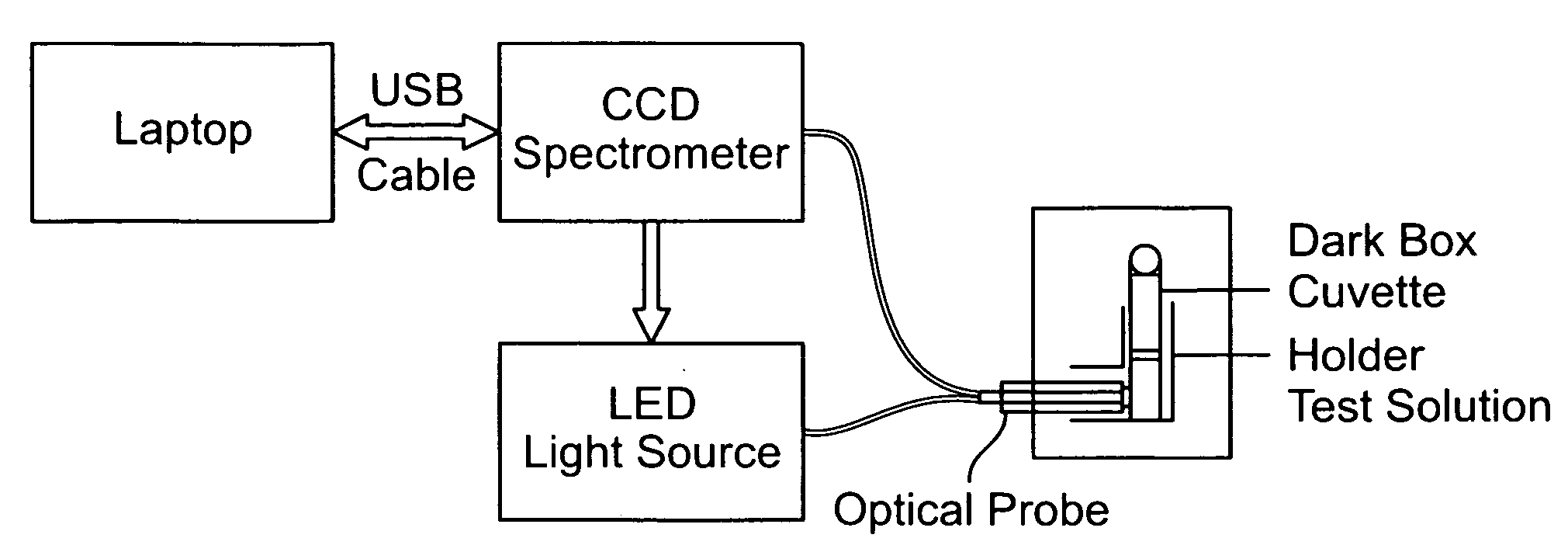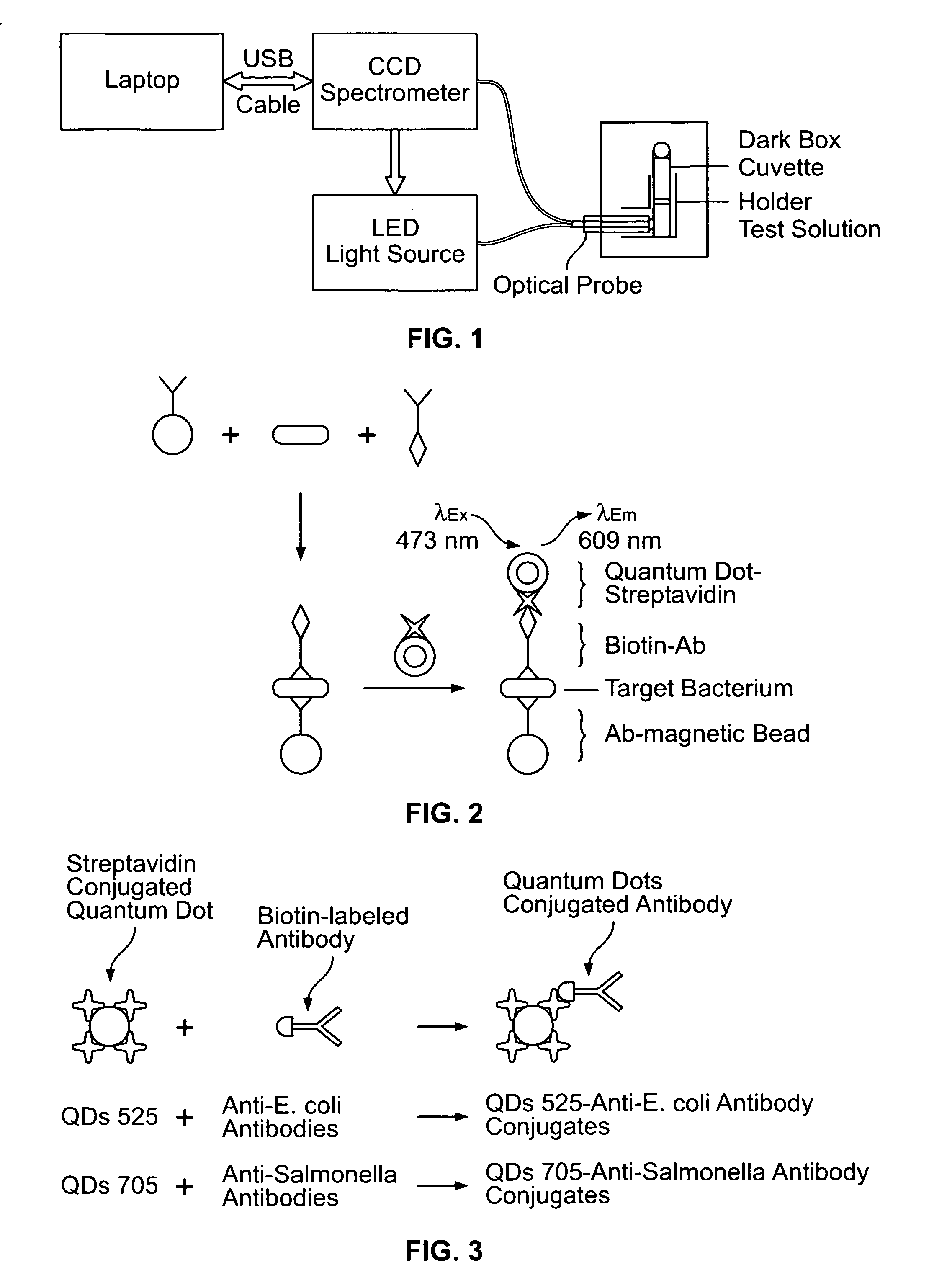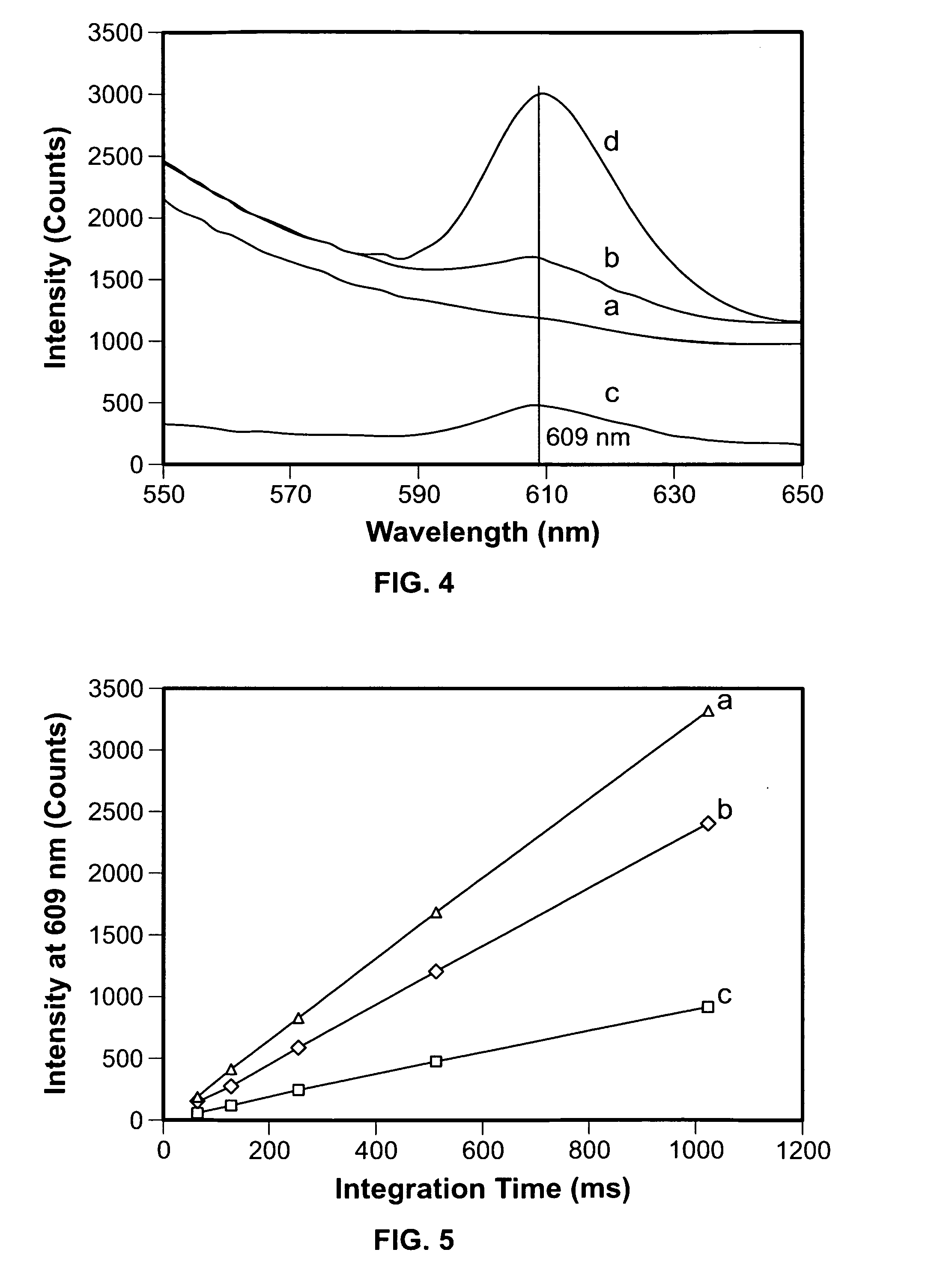Quantum dot biolabeling and immunomagnetic separation for detection of contaminants
a biolabeling and immunomagnetic separation technology, applied in the field of quantum dot biolabeling and immunomagnetic separation for the detection of contaminants, can solve the problems of requiring 18 or more hours, difficult to detect contaminants, and generally time-consuming
- Summary
- Abstract
- Description
- Claims
- Application Information
AI Technical Summary
Benefits of technology
Problems solved by technology
Method used
Image
Examples
example 1
Detection of E. coli O157:H7 with QD Biolabeling Coupled with Immunomagnetic Separation
[0047]Reagents. CdSe—ZnS quantum dot (QD)-streptavidin conjugates (10-15 nm in size) having a maximum emission wavelength of 609 nm (Qdot 605, Cat. #1000-1) and the incubation buffer (Qdot™ 605, Cat. #1000-1) were obtained from Quantum Dot Corp. (Hayward, Calif.). Superparamagnetic, polystyrene microscopic beads covalently coated with affinity-purified polyclonal anti-E. coli O157 antibodies (Dynabeads anti-E. coli O157, diameter 2.8 μm, Cat. #710.04) were purchased from Dynal Biotech Inc. (Lake Success, N.Y.). Biotin conjugated anti-E. coli antibodies (Cat. #B65109B) were supplied by Biodesign International (Saco, Me.). Fluorescein isothiocyanate (FITC)-labeled affinity purified anti-E. coli O157:H7 antibodies (Cat. #02-95-90) were manufactured by Kirkegaard & Perry Laboratories (Gaithersburg, Md.). Phosphate buffered saline (PBS, 0.01 M, pH 7.4) and 1% (w / v) bovine serum albumin (BSA)-PBS (pH 7....
example 2
Fluorescence Intensity is Related to Contaminant Quantity
[0053]After subtracting the background signal of the blank, the intensities of fluorescence emission at 609 nm were correlated to the cell concentrations of E. coli O157:H7. Typical fluorescence spectra of 101-107 CFU / mL E. coli O157:H7 are presented in FIG. 6 after subtracting the blank. As shown in this figure, the spectra of 103-107 CFU / mL all have a peak emission around 609 nm, but those of 101 and 102 CFU / mL do not have such a peak. The peak intensity at 609 nm as a function of the cell concentration is illustrated in FIG. 7. The intensity of the peak increases with increasing cell concentration in the range of 103-107 CFU / mL. However, the signals of the blank and the samples of 101 and 102 CFU / mL are not distinguishable. The limit to the level of detection may be due to the high background reflection / backscattering of the beads. The detection limit obtained in this work was ca. 103 CFU / mL and the total detection time, fr...
example 3
Comparison to Traditional Fluorophores
[0054]FITC-labeled anti-E. coli 0157 antibody solution containing ca. 170 nM FITC was tested for labeling the target for comparison to the QD detection method described above. Measured on the CCD spectrometer with the blue LED as excitation source, the FITC-labeled antibody solution showed a peak fluorescence emission at 521 nm, and the relative peak intensity of FITC to QD was 1:230. However, the FITC-labeled targets did not give any emission peaks and the sample signals could not be discriminated from the blank at a concentration of up to 106 CFU / mL. A Fluoro-Tec fluorometer (St. John Associates, Beltsville, Md.) configured specifically for the FITC measurement was thus used for detecting the FITC-labeled targets. The fluorometer utilizes a 931 B photomultiplier tube (PMT) as detector, which is more sensitive but also more expensive than the CCD detector. Using the PMT-based fluorometer, the FITC-labeled targets were detectable at a sample con...
PUM
| Property | Measurement | Unit |
|---|---|---|
| size | aaaaa | aaaaa |
| excitation wavelength | aaaaa | aaaaa |
| FWHM | aaaaa | aaaaa |
Abstract
Description
Claims
Application Information
 Login to View More
Login to View More - R&D
- Intellectual Property
- Life Sciences
- Materials
- Tech Scout
- Unparalleled Data Quality
- Higher Quality Content
- 60% Fewer Hallucinations
Browse by: Latest US Patents, China's latest patents, Technical Efficacy Thesaurus, Application Domain, Technology Topic, Popular Technical Reports.
© 2025 PatSnap. All rights reserved.Legal|Privacy policy|Modern Slavery Act Transparency Statement|Sitemap|About US| Contact US: help@patsnap.com



